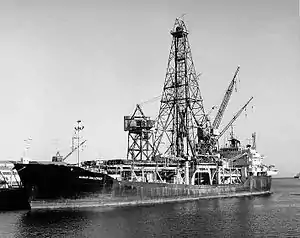 | |
| History | |
|---|---|
| Name | Glomar Challenger |
| Owner | Global Marine Inc. |
| Builder | Levingston Shipbuilding Company, Orange, Texas |
| Laid down | October 18, 1967 |
| Launched | March 23, 1968 |
| Acquired | August 11, 1968 |
| In service | 1968 |
| Out of service | 1983 |
| Identification | IMO number: 6904636 |
| Fate | Scrapped, c. 1983 |
| General characteristics [1] | |
| Type | Deep sea drilling platform |
| Length | 400 ft (120 m) |
| Beam | 65 ft (20 m) |
| Draft | 20 ft (6.1 m) |
| Speed | 12 knots (22 km/h; 14 mph) |
| Endurance | 90 days |
| Sensors and processing systems | ITT Model 4007AB Satellite Navigation System |
| Notes | Could drill to a depth of 22,500 ft (6,900 m), in a water depth of up to 20,000 ft (6,100 m). |
The Glomar Challenger was a deep sea research and scientific drilling vessel for oceanography and marine geology studies. The drillship was designed by Global Marine Inc. (now Transocean Inc.) specifically for a long term contract with the American National Science Foundation and University of California Scripps Institution of Oceanography and built by Levingston Shipbuilding Company in Orange, Texas.[2] Launched on March 23, 1968,[2] the vessel was owned and operated by the Global Marine Inc. corporation. Glomar Challenger was given its name as a tribute to the accomplishments of the oceanographic survey vessel HMS Challenger. Glomar is a truncation of Global Marine.
Purpose
Glomar Challenger was built to help Harry Hess with the theory of Seafloor Spreading by taking rock samples confirming that the farther from the Mid-ocean ridge, the older the rock was.
Accomplishments
Starting from August 1968, the ship was embarked on a 15-year-long scientific expedition, the Deep Sea Drilling Program, criss-crossing the Mid-Atlantic Ridge between South America and Africa and drilling core samples at specific locations. When the age of the samples was determined by paleontologic and isotopic dating studies, this provided conclusive evidence for the seafloor spreading hypothesis, and, consequently, for plate tectonics.
During 1970, when doing research in the Mediterranean Sea while supervised by Kenneth Hsu, geologists aboard the vessel brought up drill cores containing gypsum, anhydrite, rock salt, and various other evaporite minerals that often form from drying of brine or seawater. These were the first solid evidence for the ancient desiccation of the Mediterranean Sea, the Messinian salinity crisis.
Fate and legacy
After being operated for fifteen years, Glomar Challenger's active duty was ended during November 1983 and she was later scrapped. Her successor, JOIDES Resolution, was launched during 1985.
Glomar Challenger was a success in collecting rock samples and helped to confirm the Messinian Salinity Crisis theory.
See also
- Mediterranean Sea
- Scientific drilling
- Continental Drift
- GSF Explorer, formerly USNS Glomar Explorer (T-AG-193)
- Harry Hess
 Oceans portal
Oceans portal Science portal
Science portal
References
- Notes
- ↑ "The Glomar Challenger and Her Capabilities" (PDF). Deep Sea Drilling Project Reports and Publications. pp. 452–453. Retrieved 17 May 2014.
- 1 2 Ocean Drilling Program: Glomar Challenger drillship
- Bibliography
- Hsu, Kenneth (1987). The Mediterranean Was a Desert: A Voyage of the Glomar Challenger. Princeton University Press. ISBN 0-691-02406-5. (About the campaign that discovered the salt residues under the Mediterranean.)